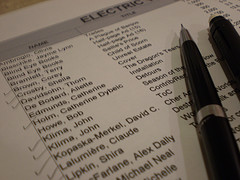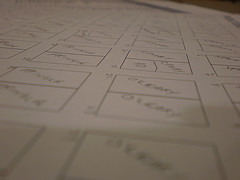It’s been conspiculously quiet in the Klima camp the second half of September. There’s one reason for that: Electric Velocipede. I’m trying to get the next issue ready to go to the printer, and it being a double issue and all, it’s taking more effort to get everything done. Most days my brain feels all stretched thing and worn out.
Of course, if I was organized I would have gotten things done several months ago . . . but that didn’t happen so there’s no point in wishing for it.
As it is, I’m up against getting the issue layout finalized, receiving ads, sending the issue out to proofreaders, and a whole legion of other teeny tiny issues that crop up without warning.
So, instead of working on all the things I need to get done with the issue, I thought I’d write a few posts that speak to the steps to getting the issue laid out and sent to the printer.
Step #1, choosing the issue’s contents.
For a long time, Electric Velocipede operated on a first-come, first-serve basis for filling up an issue with fiction. I would be open to submissions for three months, closed for three months, open for three months, closed for three . . . you get the picture. This worked just fine for the first ten or so issues, but then the magazine got more popular and the volume (and quality) of submissions far outstripped the twice a year publishing schedule. At the moment, I’m closed to submissions as I have enough fiction to last until issue #20, and I’m working on issues #15/16.
Regardless, I decided on an issue’s contents based on the oldest things I had accepted got published first. That’s still currently holding true, but likely in the future I will open for submissions when I need to fill an issue and close when it’s full.
So in my case, choosing what will be in an issue is fairly simple: the oldest stuff that fills up my word count goes in the issue. Sometimes, I’d move things around a little bit if I had a longer story, but mostly first in, first out.
 I create a spreadsheet of all the contents of the issue, and this spreadsheet also tracks how much I’m paying the authors, what kind of submissions it is, whether I’ve edited it, laid it out, gotten a bio from the author, sent contracts, etc. The spreadsheet is my friend. You can see to the right how I use the spreadsheet. I have an Excel template of it here, but that template is slightly out of date.
I create a spreadsheet of all the contents of the issue, and this spreadsheet also tracks how much I’m paying the authors, what kind of submissions it is, whether I’ve edited it, laid it out, gotten a bio from the author, sent contracts, etc. The spreadsheet is my friend. You can see to the right how I use the spreadsheet. I have an Excel template of it here, but that template is slightly out of date.
Step #2, deciding the order of the stories
If you look at the top of this post, you’ll see a slightly blurry photo of what looks like a series of boxes with some scribbling in them. I took this idea from Asimov’s when I worked there, but I suspect it’s not unique to them.
Each box represents a page spread in the issue. You label the page numbers, and filling in the boxes with the stories. For me, this helps in visualizing the magazine from a very high level. I can make sure that I don’t have too many shorter pieces running together, or that I don’t have back-t0-back novelettes. It also helps me see the over all story flow so I know how the content of the stories work next to each other. And it also helps me place ads.
I realize that many people do not read the magazine from page 1 to page 100, but if they did, I don’t want them to hit a bunch of similarly themed stories together, or a bunch of bleak stories together. I have some blank templates (as PDFs) in 60-page, 70-page, 84-page, and 112-page per sheet. To be honest, the 112-page layout (meaning you can make a rough layout of 112 pages on one sheet of paper) is too small for me. I like the 70-page and 84-page layouts.

You’ll also see in these photos that I use a pencil and eraser. A big eraser. A lot of things change as you start writing stuff out. You can fill in pages for a 20-page novelette and realize that it’s sitting on top of a 12-page short story. Maybe one should shift a few pages so you can drop in some poetry or a shorter story.
In some ways, this is the part of the process I enjoy the most. It’s like rolling up characters for AD&D. The sky’s the limit at this point. Anything and everything could happen. I’m not commited to anything; I can change things around as much as I want. But like rolling up characters, this process can be tedious. Occasionally I find I picked a page layout template with too few pages and I need to scrap the whole thing and start over. I hate relabeling the page numbers (which I should hard-code into the document, I’ve just never gotten around to it).
After this point, we’re ready to get documents prepped for flowing into the desktop layout program, which I’ll cover in another post.
[Images taken from my Flickr account; used with my permission.]










